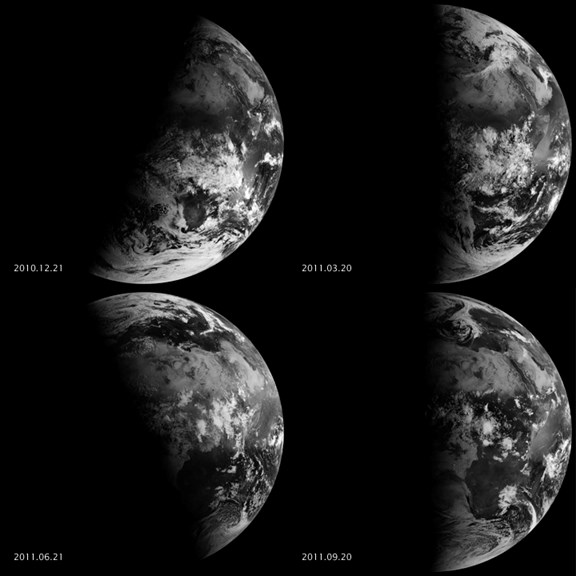Skynotes: March 2023
Upcoming events
Mars space travel, health and fiction
ANU is researching how effective fiction is in the social understanding of the health concerns of Mars space travel, and you are invited to contribute!
Autumn equinox
This month on Tuesday 21st we have almost equal lengths of day and night - the equinox – when Earth’s axis leans neither toward nor away from the sun. We are at midway between summer and winter solstices. See Earth below and Equinox: Almost Equal Day and Night at timeanddate.com.

The images clearly show the effect of a fixed tilted axis. At solstices one hemisphere leans towards the sun while the other leans away, and at equinoxes neither hemisphere leans.
Image: NASA and Robert Simmon using EUMETSAT data
To more fully appreciate equinoxes and solstices, enjoy this remarkable time-lapse sequence from NASA Earth Observatory which shows our sunlit Earth from 2010-2011. NASA images animated by Robert Simmon using EUMETSAT data
See NASA Earth Observatory's full page:
Melbourne Sun times
| Date | Rise | Set | Day length | Solar noon§ |
|---|---|---|---|---|
| Wednesday 1st | 7:03 | 8:00 | 12:56 hrs | 1:32 |
| Saturday 11th | 7:13 | 7:45 | 12:32 hrs | 1:30 |
| Tuesday 21st | 7:23 | 7:31 | 12:07 hrs | 1.27 |
| Friday 31st | 7:32 | 7:15 | 11:43 hrs | 1.24 |
§ When the sun is at its highest, crossing the meridian or local longitude.
Moon phases
| Phase | Date |
|---|---|
| Full Moon | Tuesday 7th |
| Third Quarter | Wednesday 15th |
| New Moon | Wednesday 22nd |
| First Quarter | Wednesday 29th |
Moon distances
Lunar apogee (furthest from Earth) is on Saturday 4th at 405,889 km.
Lunar perigee (closest to Earth) is on Monday 20th at 362,696 km.
Planets
Mercury is about to move behind the sun afterwards will be too close to be seen this month.
Venus is visible early in the month soon after 8pm in the west at dusk before setting by 9pm. It will be visible a little earlier each evening until by late March can be seen from 7.40pm.
Earth experiences an equinox this month. Here in the southern hemisphere it will be Autumn Equinox on Saturday 20th. The Sun will be seen rising almost due east and setting virtually due west. The term ‘equinox’ comes from ancient Latin aequinoctium (equal night) and then later medieval equinoxium. On the 20th the axis of Earth, tilted 23.5 degrees from its orbital path around the sun, will not lean away from the sun as it does in winter, nor towards the sun as in summer.
However, not being in an equatorial region, at Melbourne’s latitude (37.8 degrees south) the equal day and night hours will occur a few days later on Wednesday 24th. This four-day delay is because the atmosphere bends or refracts light from the sun allowing us to see the sun a little before it physically rises, and for a short time after it has actually set.
After the Autumn Equinox, the sun’s daily path across the sky will shift northward and be a little shorter each day over the next three months until we reach the mid-year Winter Solstice at which time our planet’s axis will lean the southern hemisphere away from the sun.
Mars can be seen in the north from 8.30pm before it sets around midnight. By the end of the month it will visible from 8pm before dropping below the horizon by 11.30pm.
Jupiter can still be seen early this month very low to the west at dusk before setting, but mid- March it will have moved too close to and then be behind the sun and so be lost to view.
Saturn will reappear from mid-month in the eastern sky before sunrise at around 5.20pm and by the end of the month is will rise from 4.40pm before fading in dawn light.
International Space Station
ISS orbits every 90 minutes at an average distance of 400km appearing like a bright star moving slowly across the night sky. Here are some bright passes expected this month over Melbourne.
Evening
Friday 3rd 9:06pm – 9:11pm South-West to North-North-East
Saturday 4th 8:17pm – 8:24pm South-West to East-North-East
Morning
Thursday 23rd 6:14am – 6:20am North-West to South-East
Heavens Above gives predictions for visible passes of space stations and major satellites, live sky views and 3D visualisations. Be sure to first enter your location under ‘Configuration’.
Meteors
The Gamma Normids meteors peak around the 15th of this month. They are centred near the star Gamma Normae, the third brightest star in Norma, the level which lies between Scorpius and Centaurus. They are a minor shower and it would be best to look from midnight to dawn from a dark sky location.
See:
Stars and constellations
In the north and north-west
Orion, the hunter is the north after sunset and upside down here in the southern hemisphere with three bright stars forming Orion’s Belt (or the base of The Saucepan from our southern perspective. The fuzzy object in the centre of his scabbard (which runs to the upper left) is M42, the Orion nebula. Lower right in Orion is the red supergiant star Betelgeuse which has an obvious orange-red colour, and to the upper left in Orion is the blue-giant star Rigel.
To the left of Orion and lower down is Taurus the bull, its head an inverted V. This is the open grouping known as the Hyades with a foreground red-giant star Aldebaran at the end of the open V. This month the Red Planet, Mars, is below and nearby.
To the left in the north-west but lower down sits M45, the beautiful Pleiades Cluster. Over 1000 stars form the cluster but at 444 light years only a few are bright enough to be seen with the naked eye. For some cultures those few bright stars represent a group of women and they are often referred to as the Seven Sisters. In New Zealand-Aotearoa the cluster is Matariki whose appearance marks the start of the Maori New Year.
In the north-east
To the north-east and high in the evening sky sits the brightest star at night, Sirius in Canis Major (greater dog) while directly below is Procyon in Canis Minor (lesser dog).
The bright star Regulus is in the north-east which gives us the location for Leo, the lion recognisable with his head and mane making an inverted question mark in the sky.
In the south-east
As always, the Southern Cross or Crux can be seen in our skies. This time of the year it sits on its side with the Two Pointers (Alpha and Beta Centauri, the brightest and second brightest stars in Centaurus) lying below.
If you are in a dark sky location and can see the vast band of the Milky Way (billions of stars that form part of the galaxy), then you can see the dark cloud known as the Coal Sack sitting beside the Southern Cross. Such interstellar dust clouds are major features of the galaxy embedded in its disc of stars and nebulae. Our visible light view further into the galaxy is hampered by these dense cold fields of dust but, fortunately, infrared telescopes that can detect heat are better able to pierce the veil of dust and see what lies beyond.
In the south-west
Once again this month, if enjoying a dark sky, the Large Magellanic Cloud (LMC) and the Small Magellanic Cloud (SMC) can be seen in the south-west. At 163,000 and 206,000 light years respectively, these neighbouring small galaxies have collided or interacted perhaps many times with the Milky Way leaving streams of hydrogen gas between them and our galaxy. The LMC and SMC may eventually be drawn into the Milky Way. Here in southern latitudes we can easily observe them all year round, whereas from most of the northern hemisphere they are not visible.
On this day
1st 1966, Venera 3 (USSR) crash lands on Venus as first probe to land on a planet.
1st 1982, Venera 13 (USSR) sends the first colour pictures of the surface of Venus and continues transmitting data for 2 hours, well beyond the 30-minute expectation.
2nd 1972, Pioneer 10 (USA) probe launches to the outer solar system.
3rd 1969, Apollo 9 (USA) tests lunar module in Earth orbit for eventual moon landings.
4th 1979, Voyager 1 (USA) discovers the faint rings of Jupiter, with Voyager 2 taking further images four months later during its own fly-by of the giant planet.
5th 1590, Tycho Brahe discovers a comet and shows that comets are further away than the Moon.
5th 1979, two probes and a satellite are affected by ‘gamma ray bursts’ leading to study of these high energy phenomena.
6th 1986, Vega 1 (USSR) makes the first flyby of Comet Halley and returns the first close-up images of a comet.
9th 1934, birth of first human into space, Soviet cosmonaut Yuri Gagarin.
11th 1977, the rings of Uranus are discovered as the planet eclipses a distant star.
13th 1781, Uranus is discovered by Sir William Herschel (UK).
14th 1879, birth of Albert Einstein famous for photo-electric effect, relativity, and letter to US President Roosevelt on the power and destructive potential of the atom.
17th 1958, first solar powered satellite, Vanguard 1 (USA), is launched.
18th 1965, Aleksei Leonov (USSR) carries out the first spacewalk.
20th 1916, Einstein publishes his theory of gravity, the General Theory of Relativity.
23rd 2001, Russian (former USSR) space station Mir (‘Peace’) is destroyed in its planned re-entry to Earth’s atmosphere.
23rd 1912, birth of Werner von Braun, famous for leading German rocketry in World War 2 and a key figure in US space program until the 1970s.
24th 1965, Ranger 9 (USA), sends first television of the moon before crash landing.
25th 1655, Christiaan Huygens discovers Titan, the largest moon of Saturn.
27th 1969, Mariner 7 (USA) is launched to Mars.
29th 1974, first fly-by of Mercury by Mariner 10 (USA).
30th 240BC, closest approach to the Sun (perihelion) in historical records of what is now called Comet Halley.
31st 1966, Luna 10 (USSR) becomes the first probe to orbit the moon.
